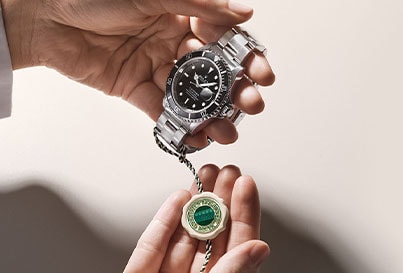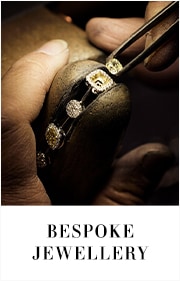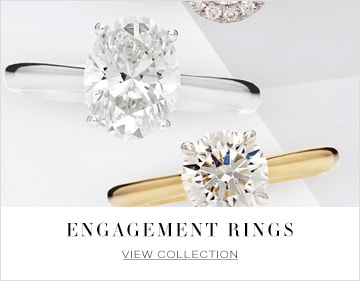The Complete Calibre Guide To Dress Watches
The Watches of Switzerland Group | 7 minute read

Just like a well-fitted suit, a classic dress watch is a must have for the modern, style conscious gentleman. With its simple and elegant stylings, a good dress watch will always remain timelessly stylish, and every watch collector should own at least one.
Historically, dress watches have been reserved for business and formal occasions. With its slim profile, the dress watch was created to tuck away elegantly under the cuff of a shirt, without spoiling the sharp lines of more formal wear. In the past, wearing any other type of timepiece with a suit would have been a huge sartorial faux-pas. However, as the rules of dressing are being redefined for the modern era, a more relaxed and personal approach is becoming the norm. Today you’re as likely to see a dress watch worn with a t-shirt and sneakers, as you are to see a pilot watch worn with a suit.
What is a dress watch?
For many horologists, there are some very strict rules around what makes a true dress watch. Whilst some of these may be open to interpretation, most agree that in order for a timepiece to be considered a dress watch it needs to be slim, elegant, and simple in both design and mechanics.
The classic dress watch should be thin, made from precious metal, with minimal complications, and attached with a high-quality leather strap. The design is also a crucial element, it should be simple and unfussy, so as not to draw too much attention. A plain dial with clear numbers, and a sleek case and bezel create an elegant and understated look. For a dress watch, less really is more, and there is a true beauty in perfecting the basics.

Grand Seiko WOS Exclusive Toge Special Edition
History of the dress watch
The first example of a dress watch appeared in the early 20th century, but its origins can be traced back much further.
During the Regency period, men’s tailoring underwent a dramatic transformation and gave rise to the two-piece suit we know today. With a more simple silhouette and an understated look, fit became paramount for the well-dressed gentleman. However, a closer fitting suit meant that carrying a bulky pocket watch would distort the clean silhouette.
And so, watchmakers set out on a quest to produce thinner and more discreet versions. For the dandies of the time, a sleeker pocket watch wasn’t just about style however, it was also a display of their wealth. A thinner watch requires a high level of skill and innovation on the part of the watchmaker, and with that comes a much higher cost.
At the close of WWI, officers returned home sporting some of the first wristwatches, and before long the wristwatch had replaced the pocket watch as the must have accessory for men. The first wristwatches were primarily practical pieces, having been created to be used by soldiers and pilots on the front lines. But back home and without the need for such practicality, watchmakers began to create more refined and elegant versions, and so the dress watch was born.
Delve deeper into the history of the dress watch to find out more.
Slim profile
These timepieces were created to be worn with formal and business attire, so that they wouldn’t interrupt the fit of a suit jacket with unsightly bunching. A slim profile, that can easily slip under a cuff, is perhaps the most important attribute of a dress watch. Watches of this style should be less than 15mm thick.
Modest size
A dress watch should be well fitting and proportional to the wearer’s wrist for the most elegant look. Look for a timepiece that is between 33mm to 41mm in size, and try on a number of options to get the perfect fit.
Simple, elegant design
A minimal look, with a focus on function, is one of the major defining characteristics of this type of timepiece. Whilst some might argue that a dress watch is a little too plain, its simplicity gives it a huge advantage over other styles. With no distractions to draw your attention away, the exquisite craftsmanship and materials can take centre stage.
Refined metal case
As a timepiece originally created for special occasions and formal wear, it’s no surprise that only the best materials will do. The case should be crafted from precious metal such as gold, silver, or platinum, but it should also be understated in design so as not to appear too flashy.
Understated dial
The dial should be minimal, and feature no extra decoration that could distract from the watches primary function – telling the time. White, cream, navy blue or black are classic colour choices, and the numbers are usually displayed in a very clear and simplistic way.
Minimal complications
When it comes to complications on a dress watch, there are two schools of thought. Some collectors believe a dress watch should have zero complications, so there are no distractions. Others think that minimal, practical complications are acceptable, provided they don’t overpower the piece. If there are complications present, the timepiece should have a second hand and a date window at most.
Leather strap
A high-quality leather strap is the perfect finishing touch. Leather sits close to the wrist, gives a snug fit and further enhances the clean lines of the timepiece.
Choosing a dress watch
The most important consideration when choosing a watch should be how it fits with your lifestyle. Where will you be wearing it? What will you be wearing it with? How does it fit? And what does its design say about you?
When it comes to choosing the perfect dress watch, first ask yourself if this is a timepiece you’ll be wearing in a more traditional manner, with strictly formal attire, or whether you want a piece you can mix in casually too. A dress watch no longer needs to be saved for best, but if you do plan to use it as an accent to your best suits, it pays to opt for a more luxurious, and expensive option.
Pairing a dress watch with casual clothing can add a luxury edge to your everyday wear, but perhaps you’d prefer it to be a timepiece that isn’t quite so precious if you’re going to wear it frequently. A non-traditional dial colour, or a distinctive design detail, are also good options for more casual wear and adding a bit of personality. And choosing a design with interchangeable straps will make for a more versatile option that can be worn with a number of different outfits.
You’ll also want to consider the fit, and how the piece looks on your wrist. It’s important for a dress watch to be well proportioned, and this means ensuring it’s not too big, or too small, in relation to your wrist. A dress watch should never be worn oversized, as this would ruin its understated elegance. It’s also important that you like the way it feels when wearing it, so it’s a good idea to try a number of different styles. This allows you to compare them against each other, understand what you like and dislike, and get a feel for your personal preferences.
Our Buyer’s Highlights
Our Head of Watch Buying, Mark Toulson has selected four timepieces that are iconic in style and heritage, truly embodying the spirit of a dress watch.
Worn by Louis Cartier himself, the Tank Louis Cartier watch sets the standard to be upheld by all Tank watches. In contrast to the assertive choice of rectangular form and proud lines, the tops of the lugs were rounded, embodying the contribution made by Louis Cartier to the modern style later known as Art Deco.
This Vacheron Constantin Patrimony Gent’s Watch is effortlessly stylish with its white dial equipped with rose gold hands and index hour markers, minute markers around the outer rim and a date window at 6 o’clock. A classic black alligator strap completes the look. Epitomising stylistic purity, the Vacheron Constantin Patrimony collection draws inspiration from the brand’s 1950s models, striking a beautiful balance between taut lines and curves. Slender cases radiate elegance and assert each model’s unique personality.





